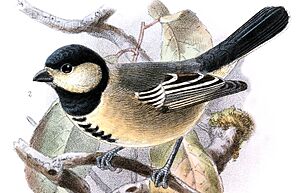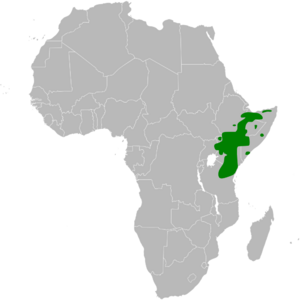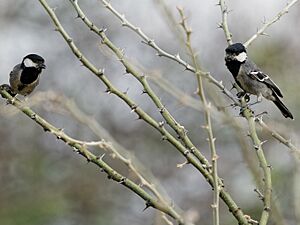Acacia tit facts for kids
Quick facts for kids Acacia tit |
|
|---|---|
 |
|
| Conservation status | |
| Scientific classification | |
 |
|
| resident range | |
| Synonyms | |
|
Parus thruppi Shelley, 1885 |
The acacia tit (Melaniparus thruppi) is a small, active bird. It is also known as the Somali tit or northern grey tit. This bird belongs to the tit family, Paridae. You can find it in dry areas of northeastern Africa, especially where acacia trees grow.
Contents
What Does the Acacia Tit Look Like?
The acacia tit is the smallest of the grey tits in Africa. It has a shiny blue-black cap on its head. Its neck, throat, and chest are also blue-black. A large, creamy-white patch goes from its beak down the sides of its neck.
There is a wide black stripe that runs from its chest down to its belly. The upper parts of its body are grey. Its wings have white patches, and there is a white spot on the back of its neck. The lower part of its body is greyish-white, with the black stripe in the middle. Its legs and beak are dark grey.
Female acacia tits usually have a thinner black stripe than males. Young birds look similar to adults but have duller colors. This bird is about 11.5–12 cm (4.5–4.7 in) long. It weighs around 12 g (0.42 oz), which is very light!
Where Does the Acacia Tit Live?
The acacia tit lives in northeastern Africa. You can find it from Ethiopia and Somalia in the north. Its range extends south to northeastern Tanzania.
This bird prefers dry and semi-dry areas with trees and bushes. It especially likes places with acacia trees. You might also see it near streams or rivers where trees grow. However, it avoids very dry desert regions. In Somalia, it has been seen at heights up to 2,000 m (6,600 ft) above sea level.
What Does the Acacia Tit Do?
Acacia tits are often seen in pairs or small groups. Sometimes, they join other types of birds to look for food together. Their diet mainly consists of small insects. They enjoy eating wasps, beetles, and caterpillars.
These birds build their nests in holes found in trees. Not much is known about their daily lives or how they raise their young.
How Scientists Classify the Acacia Tit
The acacia tit used to be grouped with many other birds in a large genus called Parus. But in 2013, scientists studied the birds' DNA. They found that the acacia tit and some other tits were more closely related to each other. Because of this, they moved the acacia tit to a new genus called Melaniparus.
The acacia tit is very similar to the southern grey tit. It is also likely related to the miombo tit and ashy tit. Scientists once thought these birds were the same species as the Palearctic great tit. However, they now believe they are not closely related.
Different Types of Acacia Tits
There are two types, or subspecies, of the acacia tit that scientists recognize:



